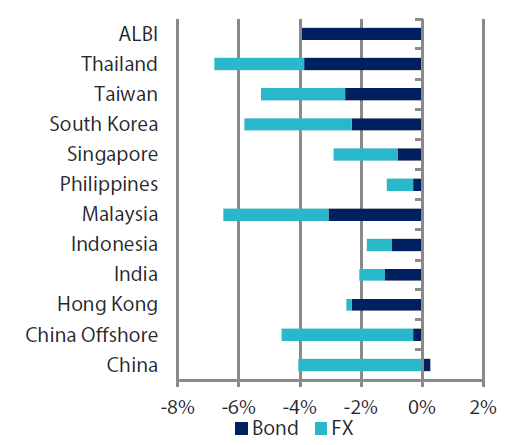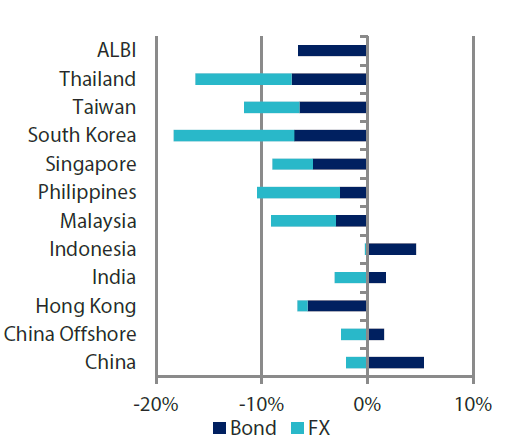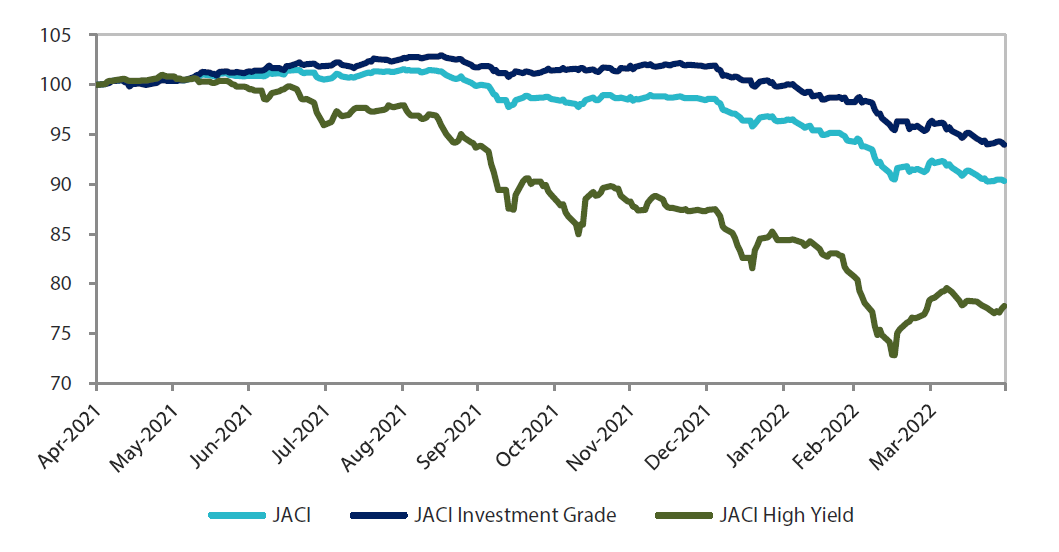Summary
- The US Treasuries (UST) yield curve shifted higher in April. The rise in yields was initially prompted by hawkish March Federal Open Market Committee (FOMC) minutes, followed by the headline consumer price index (CPI) increase and more hawkish guidance from the Federal Reserve (Fed). Yields subsequently showed signs of stabilising; at end-April, the benchmark 2-year and 10-year UST yields were at 2.718% and 2.937%, respectively, 38.1 basis points (bps) and 59.7 bps higher compared to end-March.
- Increasing energy and food prices were the main factors that pushed most regional headline CPI prints higher in March. The Bank of Korea (BOK) hiked its policy rate, citing possible higher CPI inflation and lower gross domestic product (GDP) growth, The central banks in India and Indonesia kept their policy rates unchanged.
- The Monetary Authority of Singapore (MAS) aggressively tightened FX policy. The MAS expects GDP growth to remain within the official forecast range of 3-5% in 2022 but raised its headline and core inflation forecast ranges.
- The Chinese authorities stepped up both monetary and fiscal policy support, as China struggled to contain its worst COVID-19 outbreak in two years. Towards month-end, President Xi Jinping called for an “all-out” campaign to build infrastructure among other Chinese leaders’ promise to boost stimulus. Separately, the People’s Bank of China (PBOC) lowered the banks’ FX reserve requirement ratio (RRR) by 100 bps.
- In our view the markets have largely priced in a hawkish Fed, and we are neutral on rates. We are relatively cautious on Asian currencies.
- Asian credits retreated by 2.24% in total return terms as UST yields rose. Spreads within the region, save for China, Hong Kong, South Korea, Singapore and Thailand, widened in April. Indonesian credits underperformed, which was partly attributed to the government’s ban on palm oil exports. Sri Lanka sovereigns tested new lows in April.
- There are greater downside risks to fundamentals, but we believe that the existing buffers and the anticipated policy response in China to counter the growth headwinds could prevent meaningful spread widening. We believe that the all-in yield for Asia credit has risen to attractive levels historically and provides a favourable entry point for investors with medium to long term perspective.
Asian rates and FX
Market review
UST yields rise anew in April
The UST yield curve shifted higher in April, with yields climbing between 38.1 to 59.7 bps across the curve. Hawkish March FOMC minutes prompted the initial move higher in yields. Notably, the minutes revealed that the members were inclined towards more aggressive rate hikes in the upcoming policy meetings. In addition, the declared pace of asset reduction was at the high end of consensus expectations. Data released mid-month showed that the US headline CPI increased by 8.5% year-on-year (YoY) in March, the fastest annual gain since December 1981 amid rising food and energy costs. The CPI release triggered a renewed rise in yields. The benchmark 5-year UST yield briefly breached 3% towards month-end, following more hawkish guidance from several Fed officials including the chairman. Yields subsequently showed signs of stabilising, as market focus turned to concerns on the slowing global growth amid the continued surge in COVID-19 cases in China and a much weaker-than-expected first-quarter US GDP print. At the end of the month, the benchmark 2-year and 10-year UST yields were at 2.718% and 2.937%, respectively, 38.1 bps and 59.7 bps higher compared to end-March.
Chart 1: Markit iBoxx Asian Local Bond Index (ALBI)
| For the month ending 30 April 2022 | For one year ending 30 April 2022 | |

|

|
Source: Markit iBoxx Asian Local Currency Bond Indices, Bloomberg, 30 April 2022
Note: Bond returns refer to ALBI indices quoted in local currencies while FX refers to local currency movement against USD. ALBI regional index is in USD unhedged terms. Returns are based on historical prices. Past performance is not necessarily indicative of future performance.
Inflationary pressures mostly higher in March
Increasing energy and food prices pushed regional headline CPI prints higher in March. Thailand’s overall CPI printed 5.73% YoY in the month, the fastest pace in 13 years. Singapore’s headline CPI jumped to 5.4% YoY in the same month— the highest since April 2012. In Indonesia, headline inflation picked up to a two-year high of 2.64% YoY (from 2.06% YoY in February), and core inflation accelerated to 2.37% YoY (from 2.03% YoY). In South Korea, CPI inflation rose to its highest level since December 2011. Elsewhere, India’s CPI inflation climbed to 6.95% YoY in March from 6.1% YoY in February—the highest figure since October 2020—on the back of a steep rise in food and beverages prices.
MAS aggressively tightens FX policy
The MAS announced that it would re-centre the mid-point of the policy band at the “prevailing level” of the Singapore dollar nominal effective exchange rate and increase the slope of appreciation “slightly” while keeping the width of the policy band unchanged. The statement that accompanied the decision noted that “underlying inflation pressures remain a risk over the medium term”, with policymakers expecting the economy will “record a second consecutive year of above-trend growth”. The MAS reiterated that it expects GDP growth to remain within the official forecast range of 3–5% in 2022 but raised its headline and core inflation forecast ranges to 4.5–5.5% YoY (from 2.5–3.5% YoY) and 2.5–3.5% YoY (from 2–3% YoY), respectively.
BOK hikes its policy rate; central banks in India and Indonesia maintain rates
South Korea’s central bank raised its policy rate to 1.5% from 1.25%, saying that CPI inflation will likely be “substantially” higher than its February projection, while noting that 2022 GDP growth is likely to grow less than previously forecast. During the month, Rhee Chang-yong was appointed as the new BOK governor. Elsewhere, monetary authorities in India and Indonesia left their respective policy rates unchanged.
Chinese authorities step up both monetary and fiscal policy support
The month saw China continue to struggle to contain its worst COVID-19 outbreak in two years, prompting the State Council to call for increased monetary policy support as “some of the domestic and external uncertainties are beyond expectations”. In response to this, the PBOC announced a 25 bps cut in select banks’ RRR and pledged to increase support for the real economy. Meanwhile, authorities reportedly urged commercial lenders to lower their deposit rates. Towards month-end, Chinese leaders promised to boost stimulus, with President Xi Jinping calling for an “all-out” campaign to build infrastructure.
PBOC lowers banks’ FX RRR
The Chinese yuan depreciated sharply against the US dollar, ending about 4% weaker against the greenback in April. A hawkish Fed, coupled with worries around a steeper Chinese economic slowdown on the back of increasing lockdowns in multiple cities weighed on sentiment towards the yuan. In what the markets read as an attempt to help limit the drop in yuan, the PBOC announced towards month-end that it would cut the amount of money financial institutions need to have in reserve for their foreign currency holdings by 100 bps, effective 15 May.
Market outlook
Neutral on rates; cautious on regional currencies
Expectations the Fed will deliver bigger rate hikes in the months ahead to combat rising price pressures fuelled another large rise in global rates in April. In our view the markets have largely priced in a hawkish Fed, and we are neutral on duration.
We are relatively cautious on Asian currencies. The Bank of Japan has reiterated its ultra-easy monetary policy stance, in contrast to the tighter monetary policy outlook of other developed markets’ central banks. China is sticking to its zero COVID strategy, risking further growth slowdown which could prompt further weakness in the yuan. These factors prompt us to expect broad dollar strength to persist as the yuan and Japanese yen weaken.
Asian credits
Market review
Asian credits end lower as US Treasury (UST) yields rose
Asian credits retreated by 2.24% in total return, losses driven anew by the sharp rise in UST yields, as credit spreads tightened by 1.1 bps. Asian high-grade (HG) underperformed its high-yield counterpart, slipping 2.50% with spreads widening 1.3 bps. Asian high-yield (HY) returned -1.00%, despite spreads narrowing 18.9 bps.
Asian credits opened to positive risk tone with Chinese property names leading the rally. Subsequently, hawkish guidance from the Fed weighed somewhat on sentiment, though the Chinese State Council’s call for increased monetary policy support, combined with increased Emerging Market (EM) retail bond inflows, provided an offset. Mid-month, a string of negative macro news including CPI numbers that reflected accelerating inflationary pressures globally, coupled with more hawkish Fedspeak, prompted a turn in risk tone, sending credit spreads wider. Over in China, authorities continued to struggle to contain the country’s worst COVID-19 outbreak in two years. In response to the State Council’s call, the PBOC announced a 25 bps cut in select banks’ RRR and pledged to increase support for the real economy. Meanwhile, authorities reportedly urged commercial lenders to lower their deposit rates. Towards month-end, worries around a steeper Chinese economic slowdown on the back of increasing lockdowns in multiple cities and a sharp decline in the Chinese yuan exacerbated the already fragile risk sentiment, resulting in large outflows—albeit largely from China-focused local currency bond funds. Risk sentiment improved in the last few days of April, triggered by Chinese leaders’ promise to boost stimulus, with President Xi Jinping calling for an “all-out” campaign to build infrastructure. The resumption of hard currency EM fund inflows in early April was another positive shift until late into the month, when outflows intensified.
Spreads within the region, save for China, Hong Kong, South Korea, Singapore and Thailand, widened in April. The underperformance of Indonesian credits was partly attributed to the government’s ban on palm oil exports. Notably, S&P Global Ratings revised its outlook for Indonesia’s credit ratings to “stable” from “negative”, citing the country’s improved external position and gradual progress toward fiscal consolidation, among other things. On frontier markets, Sri Lanka sovereigns tested new lows after the government suspended payments on its foreign debts and called for a debt restructure. S&P cut Sri Lanka’s sovereign rating to “selective default”, as the country missed interest payments on its international sovereign bonds. Pakistan had their fair share of political upheaval; Prime Minister Imran Khan was deposed in April by a deliberate no-confidence vote in parliament, and the country had its International Monetary Fund (IMF) loan extended by one year and the loan size increased to US dollar (USD) 8.0 billion, providing some breathing room for the new government.
Primary market activity moderates in April
The HG space saw 26 new issues amounting to USD 14.5 billion, including the USD 3.5 billion four-tranche issue from TSMC Arizona Corp and the USD 3.0 billion three-tranche issue from Freeport Indonesia. Meanwhile, the HY space saw approximately USD 3.5 billion worth of new issues raised from 14 issues.
Chart 2: JP Morgan Asia Credit Index (JACI)
Index rebased to 100 at 30 April 2021

Note: Returns in USD. Past performance is not necessarily indicative of future performance.
Source: Bloomberg, 30 April 2022
Market outlook
Greater downside risks to fundamentals but existing buffers to prevent meaningful spread widening
The combination of geopolitical tensions amidst the ongoing Russia-Ukraine war, prolonged COVID-related lockdowns across major cities in China, and tighter financial conditions as central banks globally embark on an aggressive and synchronized monetary policy tightening to control inflation will likely keep broader risk sentiment subdued in the near-term. These global and regional developments also present greater downside risks to the macro backdrop and corporate credit fundamentals across Asia, and there will likely be greater differentiation across countries and sectors. However, given existing buffers and the anticipated policy response in China to counter the growth headwinds, any near-term widening in Asia credit spreads will likely be contained. In addition, while an aggressive US rate hike cycle seems imminent, the US rates market has already re-priced significantly and this should limit the upside risk to UST yields, especially with year-on-year inflation rates likely to moderate, though gradually, from here. The all-in yield for Asia credit has also risen to attractive levels historically and provides a favourable entry point for investors with medium to long term perspective.




